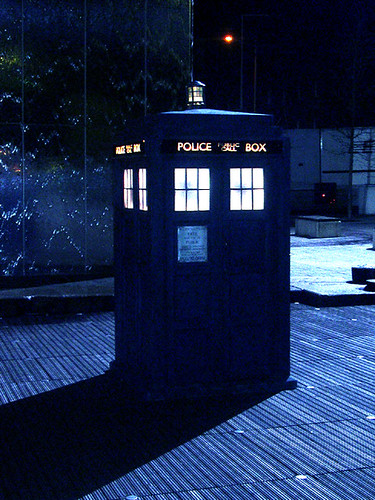Super Bowl Sunday Crystal Ball, by Circulating, from Flickr, Creative Commons license
“People assume that time is a strict progression of cause to effect – but actually, from a non-linear, non-subjective viewpoint, it’s more like a big ball of wibbly-wobbly…timey-wimey…stuff.”
The websites that we create around the narratives we tell currently focus on the objects within those narratives, like the playing pieces in a set of toys. More often than not, these are hand-crafted, static pages about certain editorially defined objects. Although we can record the links between objects implicitly as things that the audience can travel along, we tend not to expose them as things that the audience can explore and see in context. This, however, is what we are really interested in when describing narratives or telling stories. We define the objects within the world of the narrative, and then describe the interactions and changes between the objects. The intriguing thing is not necessarily the objects themselves, but the ways in which they change, or otherwise. A truly engaging website would therefore allow the audience to explore the world of the narrative not only by navigating between the objects, but by exposing and analysing the links between them, in order to derive more satisfaction.
Outside of the web, when we focus on an object, our minds give it context, and naturally establish the links between relative objects. For instance, when on a train journey, if I look out the window, I can see that branch of that tree which is placed there. We are instantly aware of both the object and its context, the thing and its links. Do the same thing with a computer, and it could identify and create a URL for a branch of a tree, but this would exist in a vacuum. It is up to us to give it the context. Using the principles and technologies underlying the Semantic Web, however, we can start to embed the context, the links, the meaning, so that, when using the web, we do not have to define these things every time. Instead, we can concentrate on uncovering and analysing those links, so that we can derive greater understanding and enjoyment from them.
Currently, websites such as www.bbc.co.uk/programmes define the objects, their contexts and links in a semantic web fashion, so that we can uniquely identify a particular object. Essentially, it provides the building blocks upon which we can establish the type of website I hae described above. Unfortunately, as far as I am aware, these building blocks are the limits of what we can currently, reliably, achieve. Emerging technologies such as SPARQL and RDF/graph visualisations will help us to build upon these blocks, but I do not think we currently have an established, reliable ‘toolkit’ or process that we can use to do this. However, this does not mean it cannot be done – it needs further experimentation. In the meantime, we can set about ensuring that the websites we build now will allow us to achieve the ideas mentioned above.
In the context of the BBC, there are two areas in which I can imagine the benefits of such an approach. The first, I will only give a overview of, as I have only thought briefly about the possibilities. The other, regarding fictional narrative, has been the focus of my previous blog posts, and I will continue the discussion here.
The first area is sport, particularly football. The BBC Football website contains a wealth of information, covering what is, in effect, the (almost) closed-off world of football. Fans essentially are following a narrative which spans matches, clubs, leagues, seasons, cup competitions etc. There is, obviously, some organisation taking place on the website – organising the clubs into their leagues, for instance. However, the links between these things – and here I mean not just the clubs, but the players, the action – are rarely revealed. We know that a team is relegated from a division because on one day their page exists within the ‘Premier League’ section, whereas the next, they are in the ‘Championship’ section. Their history may be recorded on the team’s page, or preserved in the numbers of a league table for a particular season, but there is no way of effectively (and, most importantly, engagingly) charting their fortunes. Of course, we can present these things in the numbers and bar charts and graphs, but they do not take advantage of the existence of the narrative behind them – which is really what people are interested in. Similarly with players. When two players go in for a tackle, we know that they have a history of confrontation, or perhaps an embarrasing own goal incident – what if we could provide the context around that tackle as and when, and after, it happens – filling in the back story, and getting the audience excited and engaged.
Similarly, by identifying and putting objects and events in context, we can give the audience something to latch on to. Take, for instance, a penalty incident. Say that the match was being covered on 5 Live with a commentary, it was shown and discussed on Match of the Day by pundits, and then also talked about on forums and 606 by fans. If we had an identifiable ‘hook’ for the incident, then potentially we could build a page which brought together all these different interpretations and discussions of the same event. That way, the audience would have an effective overview of the incident, with informed (and perhaps ill-informed!) opinions – their understanding and enjoyment would be enhanced, and of course, they could make their own contribution.
Back to the fiction – in my last post, I linked to a couple of images within which, I tried to explain what I aim to achieve, and where the benefits could be found. The first diagram establishes the episodes as a whole, regardless of series – and then drills down to a particular series, and a particular episode. A website that deals with a fictional narrative needs to remember that the episodes are merely a window onto the universe for the audience. If we intend to allow the audience to fully explore the universe, then apart from pointers leading them from/to episodes, as a form of ‘way-in’ (which, incidentally, should probably be through /programmes) the episodes themselves should (probably) not be included – all that exists are the objects (the places, the times, the characters) and the events.
The first diagram, once an episode has been specified, identifies the characters and events within the episode that are crucial to the narrative. For this, I limited myself to a handful of events and characters, which meant that I did not fully get the richness of the narrative across. However, potentially, we could identify as many events etc. as we require. Below the timeline of events (as presented to the viewer) there are coloured blobs, representing the characters in the events. This view shows us how the characters come and go throughout the episode (for instance, the Doctor only really appearing at certain points in the beginning, middle and end).
The second diagram gets closer to the value of this kind of site. Here, we see that the way in which each character experiences the events of the episode is quite different. This is crucial both to the plot and to the audience’s understanding and enjoyment of the episode. If, for instance, you wondered exactly how things tied together, then exploring this kind of site would allow you to piece together the parts of the puzzle. Perhaps on each character’s page, we would show their timeline, and how things happened to them. From the Doctor’s perspective, for instance, the event at the end of the episode is the first thing that happens to him – and the last from Sally’s point of view. Also, by showing these different timelines in the context of each other, we see the intricate way in which Steven Moffat (the writer) is able to weave the story together – giving the audience a greater appreciation of the story as a whole.
Obviously, Blink (so far) is an atypical episode of Doctor Who. By and large, the stories do not tend to concern themselves with the ‘timey-wimey’ stuff. However, over the course of a series, or indeed several series, characters, events etc re-appear – for instance the ‘Bad Wolf’ motif – the reason that the cliffhanger to ‘Turn Left’ works so well, is because it draws together elements of continuity established throughout several series. The audience gets maximum enjoyment out of such a moment because they are aware of the links and the context.
So what of the original series, whereby both ‘timey-wimey’ stuff and ‘story-arcs’ were at a minimum? Well, there are still instances of recurring themes, but overall, stories are self contained. That’s fine – they could be slotted into this kind of website just like everything else, because it essentially gives us a great pool of narrative to draw upon – if and when needed. Crucially, though, they represent a pool of ideas that future writers can draw upon if they wish. Continuity should not restrict the writing of future stories – the previous stories merely open out the fictional universe, creating more richness for authors. As such, when feeding the ‘classic’ stories into the website, the site becomes a form of ‘official’ wiki. Users can and should be encouraged to contribute, as a form of writing their own stories, but a distinction can be drawn between the events depicted on screen (it is, after all, and should not be forgotten, a television show..) and those where people ‘fill in the gaps’. The series itself has touched upon this, with the idea of certain events being ‘fixed points’ and others being ‘in flux’. As long as the narrative is not disrupted (i.e. breaks down so that it no longer makes sense to the audience) or becomes to insular (i.e. relying too heavily on continuity, so that new audiences are driven away), then continuity can enhance the fictional narrative universe as a whole.
Finally, a new diagram which, on a very basic level, tries to illustrate the idea that the website could be explored and presented through the model of, as quoted above, “a big ball of wibbly-wobbly…timey-wimey…stuff.” The diagram is quite obviously incomplete, but the idea is that the objects and the links between them are visualised, and the audience can then choose to look at a particular object, and see how it ties in to everything else – seeing both the object and its changing context and perspectives at the same time.
Phew. That’s enough for now. Till next time…




